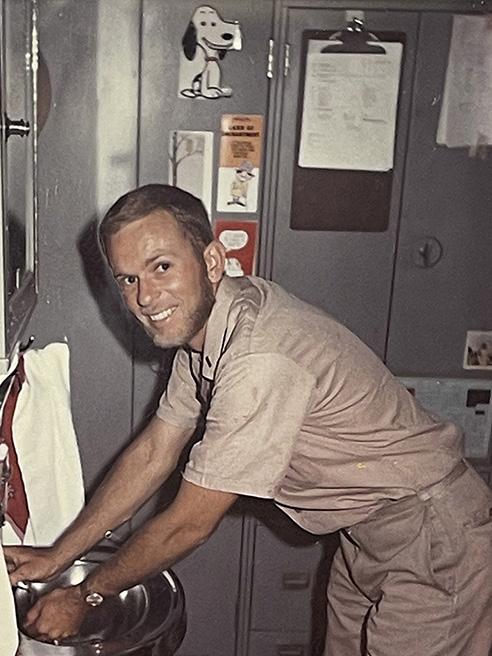
4 minute read
San Diego Veteran Spotlight
Gary Chapman
By David Koontz
A San Diego native, Gary Chapman grew up in Navy town. As a boy, he watched with fascination naval ships steaming in San Diego Bay as well as military aircraft flying from Naval Air Station North Island. So it was no surprise what his future held.
“Sailing in the bay growing up, watching the ships and seeing the seaplanes take off and land, it was pretty much a foregone conclusion the Navy would be my branch of service,” said Gary, who graduated from Point Loma High School in 1962.
After graduating from the University of Utah on a Navy ROTC scholarship, Gary was commissioned an ensign and assigned to the destroyer USS Ault (DD698). Later, as the gunnery officer on the destroyer USS Rogers (DD-876), his ship came under attack off the coast of North Vietnam in the Gulf of Tonkin during Operation Sea Dragon in 1967. “The Rogers was bracketed by North Vietnamese artillery on one of our Sea Dragon firing missions,” remembered the 76-year-old Gary. “There was a big splash on the port bow, then a bigger splash off the starboard side aft. We went to right full rudder, all ahead flank, and returned counter-battery. Fortunately, the ship did not take a hit, but it was close.”
Combat operations for Gary didn’t end when he left the Rogers. His next tour kept him in Vietnam and even closer to the action. Assigned to River Assault Flotilla 1 (RAF 1), he spent a year in the Mekong Delta.
“RAF 1 was a joint Army-Navy task force in the Mekong Delta and I was weapon’s boss on the USS Colleton, one of two mother ships for the RAF,” said Gary. “We had 9th Army Division assigned to us and their smaller craft would tie up to pontoons we had lashed alongside.”
The Colleton, and another mother ship, would go up the main river channels as far as the Cambodian border. The smaller assault boats would carry Army troops up the smaller channels to seek out the enemy. The boats would return to the anchorage at night and the troops would sleep safely aboard the Colleton.

“The enemy learned quickly that it did not pay to launch rockets or shoot recoilless rifles at us while we were at anchorage as our return fire was devastating,” recalled Gary. “Many people didn’t realize how successful the mobile riverine force was. The enemy was effectively driven out of the area after some hard fighting.”
After leaving the Navy in 1972 and earning his MBA from the University of Southern California, Gary spent the next 20 years in the computer industry as a systems analyst, project manager and product marketing vice president with several national and international companies.
Gary ultimately started his own multimedia production company called Imagix Studios before retiring in 2006.
It wasn’t long into his retirement when some friends suggested that he consider volunteering for the USS Midway Museum.
“I was interested, but was already heavily involved in another volunteer group, so I kept putting off going to check out the Midway,” said Gary. “But one day, I figured I might as well go visit the ship. I thought I would spend an hour or two aboard, but was blown away and didn’t leave the museum until it closed. I knew then how I would spend the rest of my retirement.”
He began volunteering on Midway in 2009 and has amassed more than 10,000 volunteer hours as a docent over the last 12 years.
“It’s best job I’ve ever had,” said Gary. “It’s lots of fun and you feel like you are doing something really meaningful. The museum is a unique organization and the people you meet are incredible, from all over the world.”
On top of being a docent interacting with Midway guests and telling Navy and Midway stories, Gary is also an instructor for new docents, and produces training and continuing education videos for the volunteers. He also built the docent information website.
“Gary immediately took a leadership role in the daily operations of the museum after becoming a docent,” said Jim Reily, Midway’s director of docent programs. “During COVID, his efforts were largely responsible for the ship having more than 90 percent of our pre-pandemic volunteers return to the museum to continue inspiring and educating our guests.” “Both my Navy service as a young man and serving in my retirement as a docent on the Midway are two very formative periods of my life,” said Gary. “I’ve learned a lot during both periods, and found both to be worthwhile and significant.”
Information on volunteer opportunities at the USS Midway Museum can be found at www.midway.org/give-join/volunteers.











